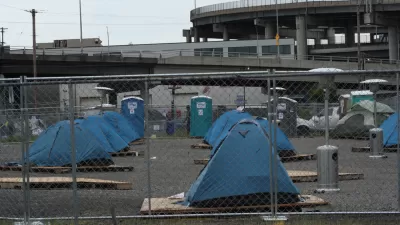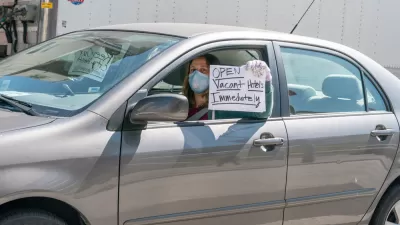Los Angeles is the nation's capital of both crowding and sprawl. A feature published by the Los Angeles Times provides the history of how the metropolis achieved this contradiction.

Whether it's fair nor not, Los Angeles is a symbol of the unfettered expansion of sprawl in the United States. So that should mean backyards and large, spacious homes for everyone, right?
Look beneath the surface, however, and the reality of the Los Angeles region is revealed as an overcrowded housing market—multiple families and households shoehorning into a housing supply not built to handle the demand of the nation's most populous county.
A feature article by Brittny Mejia, Liam Dillon, and Gabrielle Lamar Lemee, and Sandy Kambhampati for the Los Angeles Times looks past the symbolic region to reveal the consequences of the reality of Los Angeles, focusing on the consequences of overcrowded housing during the pandemic.
"At the heart of the storied metropolis of single-family-home sprawl, L.A. leaders created a cruel paradox: It is also the country’s most crowded place to live," According to the analysis reported here by the Los Angeles Times, Los Angeles County has more overcrowded housing than any other large county in the United States—a fact that has remained true for three decades.
During the pandemic, the region's hidden overcrowding in single-family homes had tragic consequences. The article places the blame for high covid death rates in low-income communities on the historic decisions made by planners and politicians: "This public health disaster was the inevitable consequence of more than a century of decisions that resulted in L.A. growing more like an endless suburb than a towering city."
- Related from Planetizen: Overcrowded Housing Connected to Coronavirus Infection (June 2020)
- Related from Planetizen: Los Angeles Mayor Blames COVID Outbreak on Density (January 2021)
- Related from Planetizen: The Link Between COVID-19 Deaths and Overcrowded Housing (July 2021)
To explain how Los Angeles achieved its paradox, the team of journalists "reviewed historical archives, oral histories and newspaper accounts, analyzed decades of U.S. census data and conducted dozens of interviews with academic experts, public officials, residents of cramped apartments and people whose family legacies in the region date back more than a century." They found a singular thread:
L.A.’s leaders could have addressed deplorable living conditions for the region’s poorest residents with more apartments, taller buildings and public housing. But they saw those ideas as anathema to the Southern California lifestyle they were creating. So in working-class neighborhoods, more and more people crammed into the existing housing stock, particularly as new streams of immigrants came from Mexico and Central America.
The entire history, along with damning judgments for 20th century planning and a warning for 21st century planning, can be read in the source article.
FULL STORY: L.A.’s love of sprawl made it America’s most overcrowded place. Poor people pay a deadly price

Maui's Vacation Rental Debate Turns Ugly
Verbal attacks, misinformation campaigns and fistfights plague a high-stakes debate to convert thousands of vacation rentals into long-term housing.

Planetizen Federal Action Tracker
A weekly monitor of how Trump’s orders and actions are impacting planners and planning in America.

In Urban Planning, AI Prompting Could be the New Design Thinking
Creativity has long been key to great urban design. What if we see AI as our new creative partner?

King County Supportive Housing Program Offers Hope for Unhoused Residents
The county is taking a ‘Housing First’ approach that prioritizes getting people into housing, then offering wraparound supportive services.

Researchers Use AI to Get Clearer Picture of US Housing
Analysts are using artificial intelligence to supercharge their research by allowing them to comb through data faster. Though these AI tools can be error prone, they save time and housing researchers are optimistic about the future.

Making Shared Micromobility More Inclusive
Cities and shared mobility system operators can do more to include people with disabilities in planning and operations, per a new report.
Urban Design for Planners 1: Software Tools
This six-course series explores essential urban design concepts using open source software and equips planners with the tools they need to participate fully in the urban design process.
Planning for Universal Design
Learn the tools for implementing Universal Design in planning regulations.
planning NEXT
Appalachian Highlands Housing Partners
Mpact (founded as Rail~Volution)
City of Camden Redevelopment Agency
City of Astoria
City of Portland
City of Laramie





























